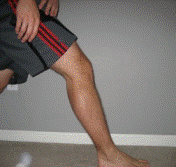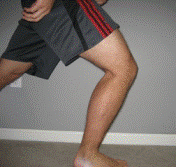How To Develop An Explosive First Step - How Having a "Long" First Step Can SLOW You Down!
In this article, we're going to cover:
- Why a quick first step is important
- How using the cue word "long" for a first step can actually slow your players down.
- How to properly execute an explosive first step.
Why is a quick first step important?
A great first step creates separation and maintains separation from the defender which can lead to many easy baskets for your TEAM.- Drive & Dump - a really good first step will get you by the first line of help defense which forces the post defense to help and leaves an easy dump pass to a post player for the dunk.
- Drive & Kick - a good first step will get you by the defender which will cause the first line of defense to sag off their man to help stop your penetration. This leads to many open shots along the perimeter.
I remember a game in high school where I simply drove at the help defender of a player that was shooting the ball really well that night. Each time, the help defender dropped down to help, the shooter was wide open. He had 6 3s in about 10 minutes.
- Drive & Kick & Pass - sometimes, the score doesn't come immediately off of your pass. A good defense will rotate on the 1st pass. After that, the perimeter player can usually make a quick pass to an open teammate for a shot. This doesn't fill up the stat sheet for you, but I guarantee college scouts and good coaches sure take notice. This will lead to more victories, more playing time, and more scholarship offers for the select few.
- Lay Up or Bunny Jumper - If the defense doesn't rotate over, you can often get an easy lay up or short little jumper for your team.
- Cause Foul Trouble For The Opposition - If you're constantly beating your defender, other defensive players will have to help which can lead to foul trouble if they do not rotate over quickly enough.
How using the cue word "long" for a first step can actually SLOW your players down!
A long first step can be beneficial in the post area to gain position. However, you often hear basketball coaches cueing their players to take a "long" first step along the perimeter.This cue of taking a "long" first step can cause players to over-stride with their first step which causes the player to slow down, lose balance, and jump poorly. This makes it easier for the defense to help and recover.
 Over-striding (or over-reaching) occurs when the lead leg makes contact with the ground and the shin angle is
greater than 90 degrees (or a 'negative' shin angle). This is not a good
position for the body to accelerate or jump. When a player reaches this position, it is actually the body's
natural 'breaking system' or way to slow down.
Over-striding (or over-reaching) occurs when the lead leg makes contact with the ground and the shin angle is
greater than 90 degrees (or a 'negative' shin angle). This is not a good
position for the body to accelerate or jump. When a player reaches this position, it is actually the body's
natural 'breaking system' or way to slow down.
This position also does not engage all of the muscles needed to generate the most force. Common sense will tell you that the more force you can produce, the more explosive and longer your step will be when driving towards to the basket.
 According to Vern Gambetta, the goal of the first step is to "create a
positive shin angle in order to produce force and get the body moving in
the correct direction with the least effort possible." When taking your
first step, you want the shin angle to be at 90 degrees or less, because
this position enables you to engage all of the muscles needed to produce
the most force.
According to Vern Gambetta, the goal of the first step is to "create a
positive shin angle in order to produce force and get the body moving in
the correct direction with the least effort possible." When taking your
first step, you want the shin angle to be at 90 degrees or less, because
this position enables you to engage all of the muscles needed to produce
the most force.
I once heard a coach say, "If you were going to race somebody without starting blocks, how would you line up? That's an ideal first step position." Your body instinctively knows what the ideal position is to produce the most force. Your goal on the first step should be to get to that position as quickly as possible.
The proper 'cue' & optimal position for taking a first step to blow by the defender:
Assuming the player is already in a good triple threat position with their hips back, knees bent, shoulders over the feet, and weight on the balls of the feet, here is a simplified version of the cues and the optimal position.- "Nose over the toes" - That's a cue I picked up from Brian McCormick that puts the player in the optimal position for having the knee over the foot and the shoulder and head above the foot.
- "Quick to the floor" - This cue tells the athlete to get the foot back down
as quick as possible, so they can quickly produce their second step towards the
basket. This also helps prevent overstriding.
Once, the player starts to improve in this area, you can add focus to the dribble.
- "Extend Dribble" - This cue tells the player to push the ball out in front of them.
- "Head Up" - This cue helps the player see the entire floor.
Focus on one or two of these cues each session and progress the players over time. Trying to give them all of these cues at once might overload the player with too much information.
I spent my entire high school career over-striding on my first step and I know from personal experience how detrimental it can be. Rather than looking for a solution, I just assumed I was not as athletic as other players and that I needed to work harder on the move which led to me adapting somewhat. I was still able to jump (poorly) while being slightly off-balance and finish at the hoop. As soon as I made this change to my first step, I felt extremely explosive and I could reach the goal much easier off of the jump. For a short while, it actually threw off my lay up, because I was not accustomed to having any spring when finishing near the goal. This was fixed with a few repetitions.
If you are looking for drills to develop speed and quickness, check out Cody Roberts Athletic Development Program.
What do you think about this? Please leave your thoughts and opinions below...
|
||||||||||||||||||||||||



 Facebook (145k Followers)
Facebook (145k Followers) YouTube (152k Subscribers)
YouTube (152k Subscribers) Twitter (33k Followers)
Twitter (33k Followers) Q&A Forum
Q&A Forum Podcasts
Podcasts